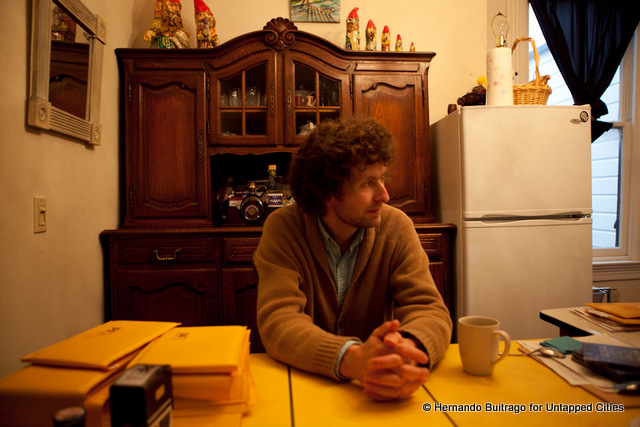 Peter Varshavsky, head of Porto Franco Records
Peter Varshavsky, head of Porto Franco Records
San Francisco family-owned Porto Franco Records started three years ago as a traditional record label. Unlike most labels, the company has produced albums from multiple musical genres-with the caveat that the music be representative of the San Francisco music scene. Today, however, after failing to recoup on their expenses, Porto Franco is refocusing. In order to better support local musicians while also achieving financial stability, they are creating less-expensive artistic media products that help raise artists’ visibility.
On a recent Friday afternoon, I sat with Peter Varshavsky, head of Porto Franco. Located inside a nicely trimmed Victorian house on Valencia Street, the apartment where our meeting took place serves as Porto Franco’s headquarters. The “office” is furnished with a piano, a vintage kitchen oven and other old-time looking items that give the space a homey feel.
The label was started by Varshavsky and his parents in order to support the San Francisco music community. Inspired by the interconnectedness of the musical scene, the label’s mission was to work with San Francisco musicians placed across a wide range of musical genres. From Darren Johnston’s free jazz, to Copperwire’s hip hop to Undercover Presents’ tribute projects, the label has released 29 albums. A handful more are scheduled for release later this year. After that, however, the label will stop producing albums and focus instead on videos of intimate live performances, blog posts and show listings.
The change in focus began about a year ago after Varshavsky realized that the company wasn’t doing well. He admits that they weren’t looking for huge profits, but they also did not want to lose money. While sales of hard-copy CD’s or mp3 downloads were slow from the first, the idea of building an audience without being able to focus on one genre proved too big a challenge. “To generate income you need to generate an audience first,” says Varshavsky. Labels that are successful generally focus on one genre and have an identifiable sound. “We didn’t have a sound,” he continues, so “we decided that we needed to create a product that was very us.”
The “very us” product turned out to be videos that show musicians performing in an intimate environment. According to Varshavsky, “a video has more promotional value than an album.” It provides a more engaged experience than an audio listen, and if it goes viral, its impact to the artist’s visibility is much larger than any other promotional outlet.
By making videos, Porto Franco also allows itself to move faster from artist to artist and across genres. “Working with an artist to make an album takes 5 to 20 thousand dollars and many months of work. Making a video takes 2 hours of scheduling, 3 of shooting and 5 hours of editing. Then, you can move on.”
The videos are very straight forward. They are usually shot with two or three cameras and portray a live performance (without an audience). They represent what happened in the room that day quite accurately, with no audio or image enhancements.
One such example is this video of local blues man Seth Augusts performing “Everything is Everywhere” at Porto Franco’s headquarters. The energy and honesty comes through in the video drawing the viewer into the space.
In addition to making videos of ensembles doing what they regularly do, Porto Franco exercises artistic direction by pairing musicians that do not regularly work together and documenting their collaboration. For Varshavsky, “To shoot something that would have happened anyway is much less interesting that to help create something new.”
[youtube https://www.youtube.com/watch?v=w2rRUjHYK6Q?rel=0]
Under this model, Porto Franco plans on recouping some money through YouTube ads and iTunes downloads of the songs from the videos, which the label hopes to make available in the near future. And even if this does not generate a lot of money, at least they won’t be spending quite as much as they did when sponsoring the production of full-length albums.
Becoming a YouTube success and being able to make a living from it is a rare occurrence, but not a far-fetched idea. Bay Area indie artists Pomplamoose are able to make a living through YouTube and iTunes downloads. In 2009, the band had been posting videos of their original recordings and popular covers when one of those videos was featured on YouTube’s front page. Now, the duo has almost 350K subscribers on the website and has sold hundreds of thousands of song downloads through iTunes. But Pomplamoose did not cross the online fame threshold solely due to the YouTube feature. By the time they were featured, they had developed an innovative way to engage viewers with videos produced around the “you see what you hear” concept.
Porto Franco experienced this success to some degree last summer when LaTosha Brown’s video of “I Know I’ve Been Changed” was featured on YouTube’s front page. Right away the video got more than 500K views. That number has now risen to more than one million. Varshavsky hopes to recreate this success with current videos.
[youtube https://www.youtube.com/watch?v=0ST66D3qpPU?rel=0]
Having worked closely with scores of musicians for the past three years, Varshavsky acknowledges that in order to be successful, artists need to be curious about promotional methods and online tools. “They should not see online promotion as a chore but as a way to channel their creative energy.” Success for today’s musicians and artists in general relies on an interdisciplinary creativity and competency. “Artists who are successful under the current model are the ones who say: I’m going to post a song every week or make a video every month [and] have something interesting every time. After two years of that, something starts happening.”
Follow Untapped Cities on Twitter and Facebook! Get in touch with the author @hernando1.







